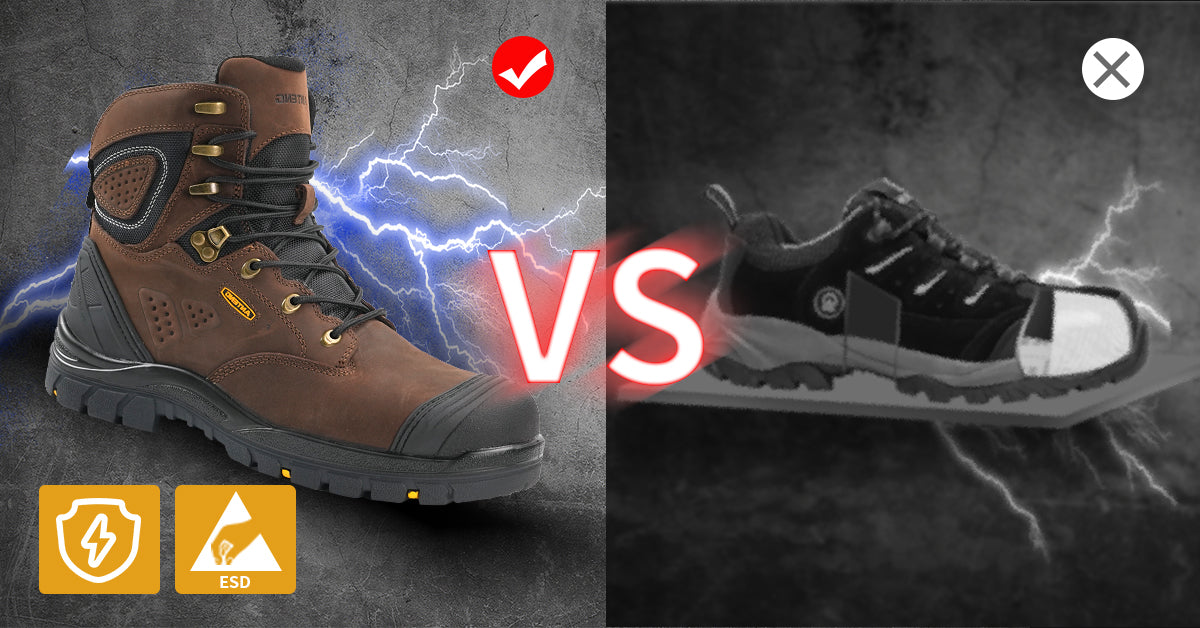
Best ESD Work Boots: Why They Matter for Workplace Safety
Best ESD Work Boots: Why They Matter for Workplace Safety
Static electricity can be a silent but dangerous problem in workplaces involving sensitive electronics or volatile substances. ESD work boots provide a crucial solution to prevent electrostatic discharge incidents, ensuring both safety and compliance.
What Are ESD Work Boots?
Electro Static Dissipative (ESD) work boots, also known as Static Dissipative (SD) boots, are designed to reduce excess static-electricity buildup as you walk around your job site or workspace. These boots allow any static charge to dissipate to the ground instead of being transferred from you to any materials, objects, or equipment in your workspace. In the USA, the term ESD is commonly used, while in Canada, SD is more prevalent. However, the underlying technology remains the same.
Why Use ESD Work Boots?
Protection for Sensitive Environments
ESD footwear is crucial in environments where static electricity can cause significant damage. These include:
- Electronics Manufacturing
- Aerospace
- Data Centers
- Server Rooms
A static charge jumping from a worker to equipment can cause severe damage in these settings. ESD-rated outsoles in work boots help prevent such incidents.
Safety and Compliance
ESD work boots are designed to meet stringent safety standards. They have an electrical resistance between 0.1 MegaOhm and 100 MegaOhm, ensuring that electrostatic charges are discharged quickly and efficiently. This makes them ideal for environments where even the most minor discharge could cause damage.
ESD vs. Antistatic Footwear
While both ESD and antistatic footwear aim to dissipate static charges, there are key differences:
- Antistatic Footwear: Has an electrical resistance between 0.1 MegaOhm and 1000 MegaOhm. It prevents the buildup of static energy in your body, avoiding sparks that could ignite fires or explosions. Ideal for environments with solvents and fuels.
- ESD Footwear: Has a lower electrical resistance (0.1 MegaOhm to 100 MegaOhm), discharging electrostatic charges about ten times faster than antistatic footwear. This makes ESD shoes suitable for protecting sensitive electronic equipment.
Compliance and Labeling
As ESD relates to meeting the requirements for the product protection standard, the labeling must be separate from the CE marking. Consequently, safety footwear that complies with the standard features an additional yellow ESD symbol. The shoes are generally antistatic if they do not feature the special ESD symbol but are labeled S1.

Measurement Methods and Factors Influencing Results
Testing Antistatic Properties
Testing the antistatic properties of shoes for certification involves a specific test method under laboratory conditions. Here’s how it works:
- Conditioning: The shoe must first be conditioned over a defined length of time in both dry and moisture-regulated atmospheres.
- Preparation: The shoe is filled with 4 kg of stainless steel balls connected to the contact resistance measurement device via a copper cable.
- Testing Setup: The shoe is placed on a copper plate as the external electrode.
- Voltage Application: A test voltage of 100 V DC is applied between the copper plate and the steel balls for one minute.
- Measurement: The contact resistance of the footwear sample is recorded. This must exceed 100 kiloohms but be less than or equal to 1 gigaohm.
Testing ESD Capability
Testing the ESD capability of shoes is slightly more complex due to different measurement procedures for the two standards:
- EN 61340-5-1: Measures the contact resistance value for the person-shoe-ground system. An employee stands on a conductive shoe testing electrode while wearing the safety footwear. The resistance is measured when they place their hand on a metal plate. The shoes are ESD capable if the measured contact resistance is less than 35 megohm.
- EN 61340-4-3: Determines the contact resistance in a laboratory process. The test object is preconditioned in a conditioning chamber at a predefined temperature and air humidity. The shoe is placed on a stainless steel plate as the first electrode, and a counter electrode is placed inside the shoe on the insole. A weight of 12.5 kg (+/- 2.5 kg) is then applied. A device measures the contact resistance between the two electrodes. It must be less than 100 megaohm for ESD certification to be granted for the respective climate class.
Choosing the Right ESD Work Boots
When selecting ESD work boots, consider the following:
- Compliance: Ensure the boots meet the required ESD standards (EN 61340-5-1) or CE standards (EN ISO 20345:2011).
- Environment: Choose boots based on your specific work environment and the level of static control needed.
- Comfort and Durability: Look for boots that offer both comfort and durability for long hours of wear.
Conclusion
Choosing the right ESD work boots is a crucial step in ensuring both personal and equipment safety in sensitive work environments. Please browse our range of top-rated ESD work boots to find the ideal fit for your needs and maintain a safe workspace. Click here to explore the YIZHONCO ESD collection and find the perfect pair.

